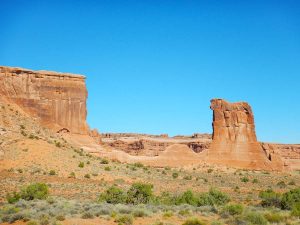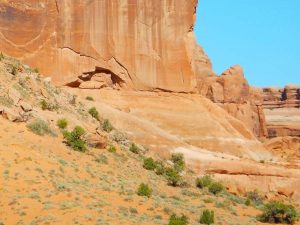Day Twenty-three: July 2
I’m posting early today, for two reasons.
First, I realized that over the time I’ve spent in this general area, with only short drives when I changed hotels, I haven’t had a day when I was off my feet for quite some time (earlier in the trip, drive days served that purpose). Actually, to be honest, I didn’t realize that directly. Instead my feet and legs said loudly “We don’t wanna hike today,” and I then figured out why. So after the morning’s sightseeing, rather than fill the afternoon with another hike I returned to my hotel for an afternoon of putting my feet up on cushions.
Second, I plan to be going out again later tonight, at the time I’d usually write my daily post. I’ve finally got a forecast for clear nighttime skies, and a park ranger gave me some tips on the best locations in Arches to photograph at sunset (when the light is just right on the formations) and then where to get the best night sky picture. So I’ll be going out to try it!
This morning I did exactly as planned. I went around to the scenic spots in Arches that I skipped two days ago. I followed up by hopping over to the Island in the Sky section of Canyonlands, to do the same thing there.
 First up today was an area called “Park Avenue,” so named because it reminded settlers of New York’s skyscrapers. It looks like a canyon a river might have dug out, but it’s actually the space between two “fins” of rock. There’s a hiking trail that runs down it and out the other side; I followed it for about three quarters of a mile before heading back— so out-and-back I did get a 1.5 mile hike in this morning.
First up today was an area called “Park Avenue,” so named because it reminded settlers of New York’s skyscrapers. It looks like a canyon a river might have dug out, but it’s actually the space between two “fins” of rock. There’s a hiking trail that runs down it and out the other side; I followed it for about three quarters of a mile before heading back— so out-and-back I did get a 1.5 mile hike in this morning.
Here’s some of what I saw:
Other sights along the way:
The above are all found in the Courthouse Tower area. Moving on from there, you come to Balanced Rock.
After Skyline Arch, I drove over to Canyonlands and to a short (half mile one way) trail to a formation called Upheaval Dome. It’s actually a bowl, more or less. So why called it “Upheaval Dome?” Because the it’s so shattered, along with the rock layers around it, that it’s as if a rock dome were turned upside down, rather than erosion sculpting out a bowl.
And here’s Upheaval Dome itself:
There are two hypotheses for how it formed:
First, a salt dome formed, pushing the rock layers upward around it (there’s a salt layer thousands of feet thick deeply buried beneath this area, left behind by the drying of the inland sea). Then ground water seeping through the fractured rock dissolved away the salt dome, so that the rocks collapsed down into the space.
Second, a meteor impact shattered the sediments, and this is the impact crater. The park service signs say the evidence currently favors the meteor hypothesis, but there remain questions and ambiguities. (I say: why not both? Maybe a meteor hit the exact spot where a salt dome had formed.)
Whatever formed it, Upheaval Dome is 200 million years old. Since it was formed, it’s been buried by later sediments, which then eroded away revealing it again— part of the reason why it’s not as clear-cut as crater as (for example) Meteor Crater in Arizona, which is far more recent.
This was the last stop on today’s abbreviated adventures. Tomorrow I drive on to Mesa Verde, which will be the last National Park on my trip. I’ll be staying in the lodge inside the park, which likely means that internet will be spotty to nonexistent; I’ll post the next journal entry tomorrow if I can, and if not then whenever I next have wi-fi.
I’ll also cover the results of tonight’s attempt at night sky photography in the next entry. Today’s trip report includes only driving miles today, I’ll add tonight’s mileage to the next total.
Trip Report:
Miles driven today: 122.4
Total miles so far: 4395.3



















